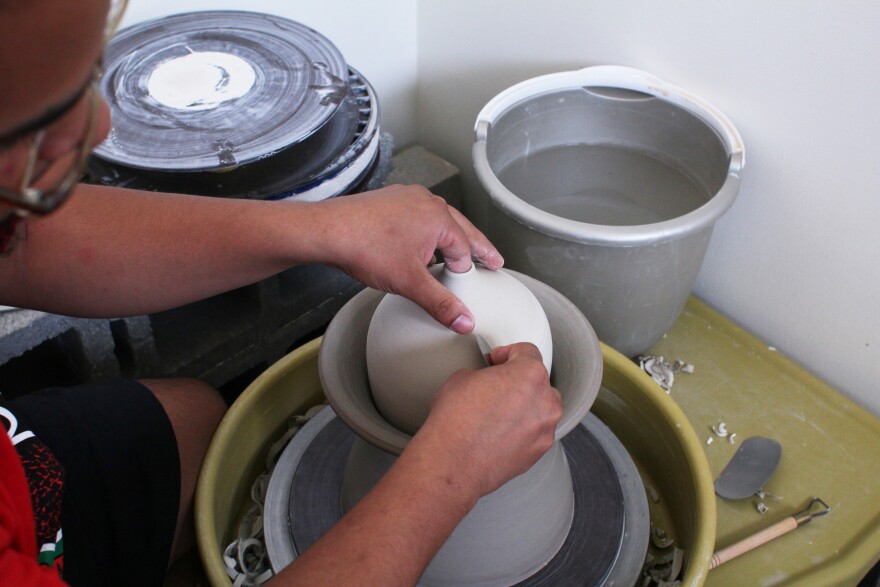Kahlil Irving sits down to the potter’s wheel in his studio, picks up an unfinished pot, the muddled grey of unfinished clay, and begins to turn the wheel. He knows the smooth pot will be glazed, fired, and pulled from the kiln, a deep, lustrous black.
Irving will add the pot to a growing collection of more than 700 other black vases and vessels, which he’ll arrange into a 20-foot-long table-like platform for the grand opening of Bruno David Gallery in Clayton. Like a demonstration blocking traffic, Irving’s sculpture manifests dissatisfaction with the systemic racism he sees throughout the art world and greater United States.
“This is like an act of protest. This is a protest, but I’m not standing outside with picket signs and yelling at you,” said Irving. “I’m yelling at you through the monument of the work, I’m yelling at you through the monument of obstructing your time and space.”
The work will be shown at a time when the controversy over an exhibit at the Contemporary Art Museum St. Louis — "Kelley Walker: Direct Drive" — exposed the racial fault-lines among St. Louis artists.
Irving's show brings to public attention issues of racial inequality in specific artworks, institutional representation, and the lack of people of color on the boards of art institutions in St. Louis.
Irving is determined to highlight the position of black artists in society.
“What brings me to the studio every day is the opportunity to challenge stereotypes and people’s perceptions of who are artists, or who is an artist, or what can an artist be,” he said.
“Undocumented” is an evolving project that subverts traditions of decorative fine-art pottery to draw attention to racial injustice and the position of black people in American society. In the United States decorative fine arts largely celebrate white, European traditions. Irving applies forms and techniques borrowed from the Euro-centric tradition to create objects that critique instances of racial injustice.
“ConcernedStudent1950: or The Johnson Family Reunion,” draws attention to how black football players at the University of Missouri stood in solidarity with other black students on campus. In November 2015, about 30 members of the team refused to play, throwing their weight behind the ConcernedStudent1950 movement, which called for the university to address systemic racism.
His work “Before and After Sundown, Town,” another part of the “Undocumented” project, addresses how St. Louis legally prevented black people from being in certain neighborhoods after dark. In each instance, collections of black vases and vessels are arranged as large scale sculptures.

Irving, 24, began developing the skills needed to execute this work half a lifetime ago. A potter’s wheel seen through the window of Potter’s Workshop in Tower Grove captivated the then 12-year-old Irving, who immediately entered the building, intending to take a class. But there wasn’t room for an interested adolescent at that time. Instructors suggested he return the following week.
“So I came back the next week and I haven’t ever stopped,” he said.
Since that time, he also has embraced printmaking, photography and other forms of image-making. Yet clay remains a staple medium of his work. In the 12 years since that initial class, Irving has studied in Kansas City, Israel, Hungary and Venice. In Israel, he produced a cement-block-based work that impeded traffic through a building’s hallway, a nod to the obstructionist tendencies of his current work. Irving’s images and sculptures have been exhibited in Latvia, Philadelphia, Texas and as part of the fair, Aqua Art Miami.
Irving intends the work to function on multiple levels and to prompt viewers to confront their own relationship to race and politics. Some, he says, likely will see the work as oppositional. But he urges viewers to question that response.
“They see it as a challenge, they see it as a protest, they see it as confrontational blackness," he said. "What does that mean and why do they see it that way?”
Some viewers will see themselves in the work. Irving hopes those people see it as a commemoration of their own identities.
“Those who share similar experiences I do, we can celebrate that this blackness is not confrontational, this blackness is to be celebrated,” he said.
For Irving, it's important to express the joys and pains of African-American life. That's why “Before and After Sundown, Town,” pivots between critique and hope.
“And part of that is because I put history in it,” Irving said. “I put in the “Before and After Sundown,” which is celebratory, which is advancing towards a better future, but I also put the reality in it.”

That urge to celebrate while advancing culture also informed his curation of the show “Their Way,” which runs through this weekend at The Millitzer Gallery in the Fox Park neighborhood. The show focuses on photographic representations of the body and how it can vacillate between strength and vulnerability. All the exhibiting artists are women. In promotional materials, the gallery notes that the show poses important questions: “We all have bodies, which lens do we see them through? What is available or unattainable? How do we view the body in and out of our control?”
A photo by Kat Reynolds depicts a bald man in an orange jumpsuit standing in an area where paving stones meet a forest.
“It pertains to blackness and it pertains to him and it pertains to his perspective of his own blackness and that’s something that is super needed right now,” said Reynolds, a friend of Irving. “Because we constantly talk about how we are not monolithic, we are all black as far as our group of friends but we all have different perspectives on things and that’s OK.”
If you go
What: Kahlil Irving’s “Undocumented”
Where: Bruno David Gallery, 7513 Forsyth Blvd., Clayton, Mo.
When: Nov. 10-Dec. 23






